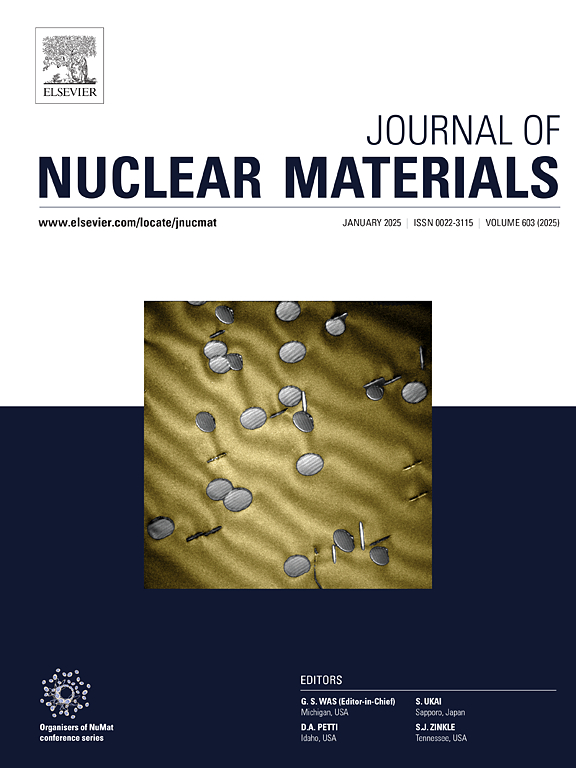Evolution of irradiated Pile Grade A graphite microstructure under novel molten salt decontamination conditions
IF 3.2
2区 工程技术
Q3 MATERIALS SCIENCE, MULTIDISCIPLINARY
引用次数: 0
Abstract
The irradiated graphite waste stream represents a significant challenge for nuclear power plant decommissioning in the UK, with an estimated 96,000 tonnes of graphite waste arising from the shutdown of the UK's gas-cooled reactors. The removal of activated impurities and fission products from irradiated graphite has been successfully performed previously [1] using an electrochemical molten salt decontamination approach. In this study, the material behaviour and structural changes of the treated nuclear graphite under molten salt treatment conditions have been assessed using multi-technique characterisation (Brunauer–Emmett–Teller surface area, Scanning Electron Microscopy, X-ray Photoelectron Spectroscopy and X-ray Diffraction). This novel research highlights that molten salt treatment leads to changes to the binder and impregnated phases while leaving the filler particles intact under the researched treatment conditions. Significant differences in atomic concentrations of C 1s deconvoluted peaks were observed, suggesting that the mechanism involved both diffusion of pre-adsorbed oxygen and limited chlorination of the surface during the decontamination process. The stability of the lattice parameters and minimal change in crystalline dimensions in molten salt-treated graphite material combined with limited mass loss provides a first-of-a-kind insight into the mechanisms behind graphite decontamination using the electrochemical molten salt approach. The findings support the future potential for wide-scale irradiated graphite treatment to achieve waste volume reduction, minimisation and re-categorisation in line with the waste hierarchy.
新型熔盐净化条件下辐照桩A级石墨微观结构演变
辐照石墨废料流是英国核电站退役的一个重大挑战,据估计,英国气冷反应堆的关闭产生了96,000吨石墨废料。以前已经成功地使用电化学熔盐净化方法从辐照石墨中去除活性杂质和裂变产物。在这项研究中,使用多种技术表征(布鲁诺尔-埃米特-泰勒表面积、扫描电子显微镜、x射线光电子能谱和x射线衍射)评估了熔融盐处理条件下处理过的核石墨的材料行为和结构变化。这项新研究强调,在研究的处理条件下,熔盐处理导致粘结剂和浸渍相的变化,同时保持填料颗粒的完整。c1s反卷积峰的原子浓度存在显著差异,表明其机制涉及预吸附氧的扩散和净化过程中表面的有限氯化作用。熔盐处理的石墨材料晶格参数的稳定性和晶体尺寸的微小变化,加上有限的质量损失,为使用电化学熔盐方法去除石墨污染的机制提供了首次的见解。研究结果支持了未来大规模辐照石墨处理的潜力,以实现废物体积的减少、最小化和根据废物等级重新分类。
本文章由计算机程序翻译,如有差异,请以英文原文为准。
求助全文
约1分钟内获得全文
求助全文
来源期刊

Journal of Nuclear Materials
工程技术-材料科学:综合
CiteScore
5.70
自引率
25.80%
发文量
601
审稿时长
63 days
期刊介绍:
The Journal of Nuclear Materials publishes high quality papers in materials research for nuclear applications, primarily fission reactors, fusion reactors, and similar environments including radiation areas of charged particle accelerators. Both original research and critical review papers covering experimental, theoretical, and computational aspects of either fundamental or applied nature are welcome.
The breadth of the field is such that a wide range of processes and properties in the field of materials science and engineering is of interest to the readership, spanning atom-scale processes, microstructures, thermodynamics, mechanical properties, physical properties, and corrosion, for example.
Topics covered by JNM
Fission reactor materials, including fuels, cladding, core structures, pressure vessels, coolant interactions with materials, moderator and control components, fission product behavior.
Materials aspects of the entire fuel cycle.
Materials aspects of the actinides and their compounds.
Performance of nuclear waste materials; materials aspects of the immobilization of wastes.
Fusion reactor materials, including first walls, blankets, insulators and magnets.
Neutron and charged particle radiation effects in materials, including defects, transmutations, microstructures, phase changes and macroscopic properties.
Interaction of plasmas, ion beams, electron beams and electromagnetic radiation with materials relevant to nuclear systems.
 求助内容:
求助内容: 应助结果提醒方式:
应助结果提醒方式:


